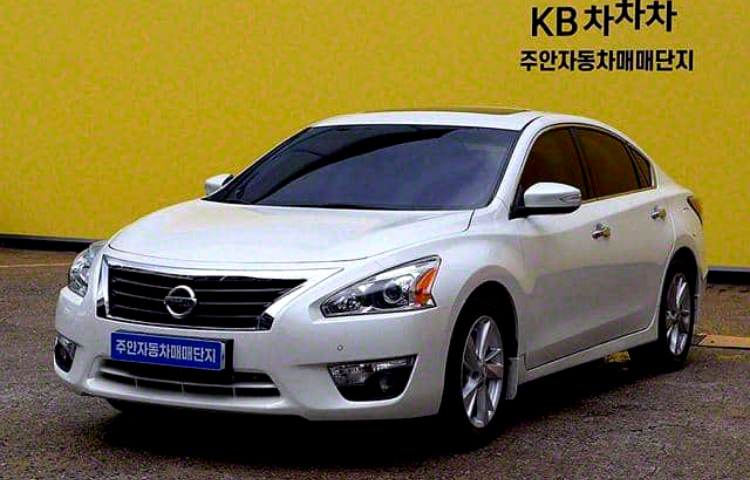Your cart is currently empty!

10 Common Nissan Altima Problems (And How To Fix Them)
Aside from being one of the most reliable sedans, there are some Nissan Altima problems that you should keep an eye out for. Pretty surprising, right? Especially when you consider that the Nissan Altima established itself as a popular mid-size sedan. It’s comfortable, stylish, and it comes with cool technology features. This is a car that competes with the likes of the Toyota Camry, Honda Accord, Hyundai Sonata, and Kia K5. Reliability-wise, the new Nissan Altima has a rating of 4.0 out of 5.0 awarded by RepairPal, while J.D. Power gave the Altima a score of 84 out of 100. Behind the appeal, some common issues have affected its reliability over the years.
If you own an Altima or are thinking of buying one, it’s important to know what problems to expect and how to deal with them. We’ll break down the 10 common problems with the Nissan Altima, what causes them, how to spot the symptoms, and what you can do to fix or prevent them.
1. CVT Transmission Failure
One of the most common Nissan Altima problems reported is the CVT transmission failure, especially in models from 2007 to 2016. Drivers often notice symptoms such as jerking or shuddering during accelerations, delayed gear responses, or unusual whining noises. Sometimes the Altima’s CVT issue can trigger the Check Engine Light. These symptoms typically point to internal issues within the CVT system and may worsen over time if left unchecked.
The root cause of this problem is usually overheating, fluid contamination, or manufacturing defects in the CVT unit itself. Unlike traditional transmissions, CVTs rely heavily on clean fluid systems to operate smoothly. Any breakdown in this system can lead to performance issues or complete failure. The problem is particularly common in older Altima models that haven’t been maintained properly.
To avoid constant repairs, you have to follow the manufacturer’s recommended service intervals. We recommend changing the CVT fluid every 30,000 to 60,000 miles using genuine Nissan parts. Also, make sure to drive smoothly to reduce strain on the transmission. If you notice early signs of transmission trouble, book a professional inspection at a certified Nissan service center. A timely checkup can make the difference between a simple fix and a full transmission replacement.
2. Excessive Oil Consumption
Excessive oil consumption is a common complaint among Nissan Altima owners, particularly in 2013 to 2016 models that have the 2.5-liter engine. Drivers often notice they’re topping up oil more frequently than usual. If you notice blue smoke coming from the exhaust, it’s a good sign that oil is burning inside the engine.
The issue is usually caused by faulty piston rings or engine design flaws that allow oil to slip into the combustion chamber and burn off. Over time, this increases oil consumption and reduces engine performance. If not checked and fixed in time, it can lead to long-term damage and may require costly repairs or a full engine rebuild.
To stay ahead of the problem, make sure to monitor your oil levels regularly, especially if you drive an older Altima model. Stick to the recommended oil type and always opt for high-quality oil. If oil levels keep dropping, it’s time to book a full engine inspection. A Nissan service center can run a diagnostic check and look for worn piston rings.
ALSO, CHECK OUT: 8 Common Problems With The Nissan Pathfinder SUV
3. Catalytic Converter Failure
A failing catalytic converter is another problem some Nissan Altima owners face. This issue often presents itself in the form of a Check Engine Light and a diagnostic trouble code P0420. The problem doesn’t usually appear overnight, though. It starts with symptoms like reduced power or declining fuel economy, which may develop slowly over several months or even a year. Many drivers don’t notice a change at first, but the performance drop becomes more obvious over time.
The problem is typically caused by a clogged or broken catalytic converter. In some cases, internal parts break apart and create blockages that restrict exhaust flow. When the converter becomes clogged, it traps exhaust gases. This prevents the engine from efficiently breaking in fresh air. This restriction leads to power loss, poor fuel economy, and eventually becomes more serious engine strain. Once the P0420 code appears, it’s a clear sign that the converter is no longer operating efficiently.
Ignoring the issue can lead to bigger problems. In extreme cases, broken catalytic material can get sucked back into the engine, causing internal damage. While replacing the catalytic converter can be expensive, delaying the repair increases the risk of costlier repairs down the line. If you see the P0420 code, book a service appointment.
4. Leaking Intake Gasket Affecting Air Flow Sensor
A leaking intake gasket is a lesser-known but fairly common issue in some Nissan Altima models. This gasket seals the connection between the air intake and the engine. When it fails, it can cause the engine to run inefficiently and reduce fuel economy. In severe cases, it can lead to engine damage. That’s because the engine relies on a precise air-fuel mixture to function properly. So, a leaking gasket disrupts that balance.
The core issue lies in how the engine measures airflow. A leak allows unmetered air (air that hasn’t passed through the mass air flow sensor) to enter the engine. The car’s computer then receives incorrect air data, leading to poor fuel injection calculations. This can cause the engine to run lean (too much air, not enough fuel), which affects performance. Because this air hasn’t gone through the air filter, it may carry debris that contributes to internal engine wear.
If you’re experiencing rough idling, reduced performance, or poor mileage, a leaking intake gasket may be the cause. Diagnosing and replacing a faulty gasket can be expensive. Delaying the repair may cause more serious problems. It’s best to have the intake system inspected by a qualified technician and ensure that the MAF sensor readings are accurate.
ALSO, CHECK OUT: 2025 Nissan Versa: Features, Performance, And Price
5. Steering Wheel Lock Failure
Steering wheel lock issues are a huge concern for some Nissan Altima owners, especially in older models. Drivers report symptoms like the steering wheel locking unexpectedly while driving, difficulty turning the key in the ignition, or warning lights flashing on the dashboard. These signs can appear gradually or come on suddenly, which makes the issue dangerous.
The common cause is a faulty steering column lock module. Electrical problems within the ignition or immobilizer system can also be the cause. When the module fails, it can prevent the steering wheel from unlocking properly. From that point, the vehicle can be unsafe to drive. In some cases, attempting to force the wheel can worsen the damage or break other steering wheel components.
If you experience this problem, avoid forcing the steering wheel and stop driving the car immediately. A certified technician can inspect the steering column and electrical systems using diagnostic tools. The fix may be as simple as replacing a module. Sometimes, more extensive electrical checks may be required.
6. Electrical System Issues
Electrical problems are fairly common in the Nissan Altima and can affect various features such as power windows and door locks. Sometimes, it can affect the dashboard displays and the infotainment system. Drivers have also reported experiencing frequent battery drain or a completely dead battery, even after recent replacements. These symptoms may seem minor at first, but can quickly become frustrating.
Most electrical issues stem from wiring faults, blown fuses, or malfunctioning components. In hotter climates, prolonged exposure to heat can worsen these problems by damaging sensitive electronics and causing connections to loosen or fail. Even the car’s AC can suffer faults if not maintained properly.
To prevent these issues, schedule regular inspections that include battery tests, fuse checks, and AC system maintenance. If repairs are needed, always use genuine Nissan parts to avoid compatibility issues and long-term damage.
ALSO, CHECK OUT: Common Problems With The Nissan Tiida C11 (And Solutions)
7. Failing Camshaft or Crankshaft Position Sensor
A failing camshaft or crankshaft sensor is a big issue that affects many Nissan Altima models. These sensors assist in engine timing and fuel injection. When one or both fail, the engine may stall while driving, fail to start, or run roughly once it does. Some drivers also report sudden drops in power and reduced fuel economy.
The issue is especially common in Altimas that have the 2.5-liter 4-cylinder or the 3.5-liter V6 engines, with affected model years ranging from 1993 to 2017. The problem became so widespread that Nissan issued a recall. But the recall is VIN-specific. That means not every Altima is covered, so owners should contact a dealership to confirm if their vehicle qualifies.
Because this failure poses a safety risk, you have to get the sensors tested during a pre-purchase inspection or if you experience any related symptoms. A professional diagnostic test can confirm sensor failure and guide proper replacement.
8. Air Conditioning and Blower Faults
Air conditioning problems are another common issue in older Nissan Altima models. Drivers often report that the blower only works on one speed, the AC fails to produce cold air, or there’s a clicking sound coming from the dashboard vents. While these may seem like minor annoyances, they can affect comfort, especially in hot climates.
These issues are typically caused by wear and tear on key AC components such as the blower motor resistor, blend door actuator, or the AC condenser. Over time, these parts can fail or become inefficient, especially if the vehicle has high mileage. A faulty blend door actuator can prevent the system from properly switching between hot and cold air. A damaged blower resistor might limit fan speed settings.
Fixing these problems usually requires an inspection to identify which part has failed. Replacing a resistor or actuator is straightforward for a trained technician.
ALSO, CHECK OUT: Nissan GT-R R35 Production Ending In America, Here’s Why
9. Suspension Wear and Noises
Suspension problems are a common issue in older or high-mileage Nissan Altimas. Drivers often report clucking noises when turning or braking, a loose or floaty steering feel, and uneven tyre wear. These symptoms are clear indicators that parts of the suspension system are wearing out and no longer performing as they should.
The causes of suspension wear include worn-out struts, ball joints, and rear link arms. Over time, these components lose their ability to absorb road impact and keep the wheels aligned. This leads to a rougher ride and reduced handling stability.
If you notice any of these signs, it’s a good idea to schedule a suspension inspection as soon as possible. Continuing to drive on a worn suspension can lead to premature tire wear and steering system strain. Replacing suspension components with genuine parts can restore handling.
10. Warped Brake Discs
Warped brake discs are a known issue in the Nissan Altima, especially in vehicles driven aggressively. Drivers typically notice vibration through the steering wheel while braking, a pulsing brake pedal, or squealing and grinding noises. These symptoms can start subtly and become more pronounced over time.
The problem is often linked to factory-fitted brake discs that aren’t built to withstand prolonged heat. When brake pads wear down too far and aren’t replaced on time, the exposed metal can generate excess heat and stress the disc surface.
To prevent this issue, stick to timely brake pad replacement and avoid prolonged or aggressive braking. If you experience vibrations or squealing during braking, have your brake system inspected by a professional. In most cases, replacing the warped discs with higher-quality rotors and fresh pads will restore safe and smooth braking performance.
Are you experiencing any problems that aren’t listed here? Send them in the comments section below.
Author Details

Our Team
Hi there! Welcome to Flagship Drive.
I’m Wilfred Nkhwazi, a passionate car lover from Africa. I created this platform to share expert insights, honest reviews, and a fresh perspective on the latest cars and automotive trends. Let’s hit the road together.
Advertisement

Recent News

